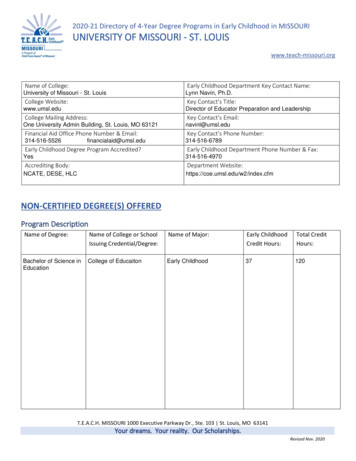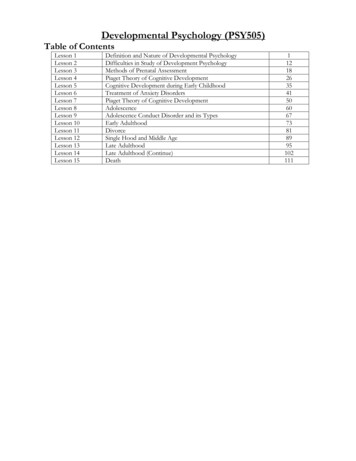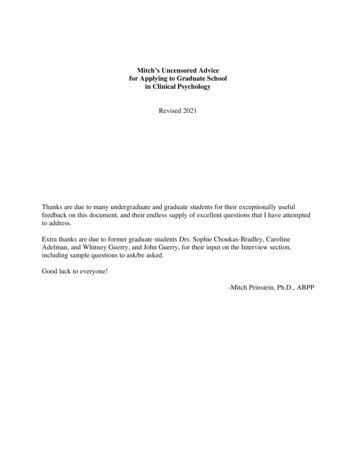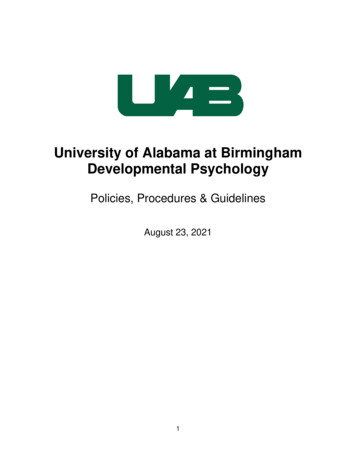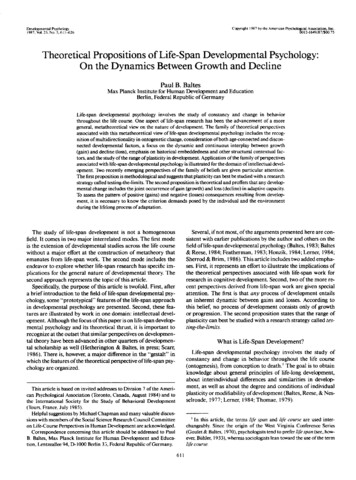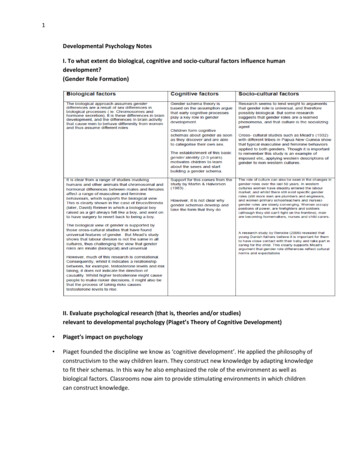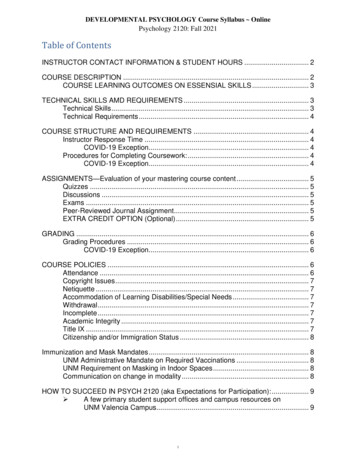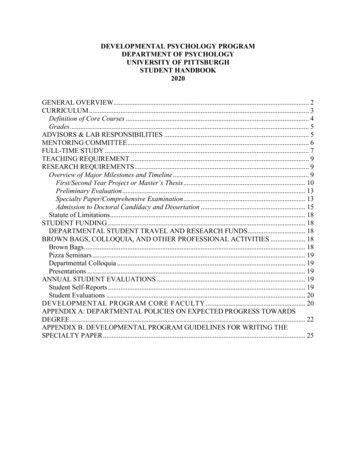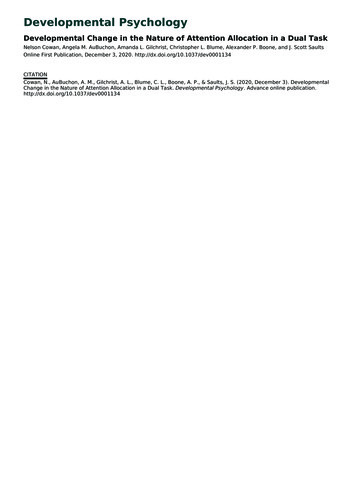
Transcription
Developmental PsychologyDevelopmental Change in the Nature of Attention Allocation in a Dual TaskNelson Cowan, Angela M. AuBuchon, Amanda L. Gilchrist, Christopher L. Blume, Alexander P. Boone, and J. Scott SaultsOnline First Publication, December 3, 2020. http://dx.doi.org/10.1037/dev0001134CITATIONCowan, N., AuBuchon, A. M., Gilchrist, A. L., Blume, C. L., Boone, A. P., & Saults, J. S. (2020, December 3). DevelopmentalChange in the Nature of Attention Allocation in a Dual Task. Developmental Psychology. Advance online publication.http://dx.doi.org/10.1037/dev0001134
Developmental Psychology 2020 American Psychological AssociationISSN: 0012-16492020, Vol. 2, No. 999, 000https://doi.org/10.1037/dev0001134Developmental Change in the Nature of Attention Allocation in aDual TaskNelson Cowan, Angela M. AuBuchon, Amanda L. Gilchrist, Christopher L. Blume, Alexander P. Boone,and J. Scott SaultsThis document is copyrighted by the American Psychological Association or one of its allied publishers.This article is intended solely for the personal use of the individual user and is not to be disseminated broadly.Department of Psychological Sciences, University of MissouriYounger children have more difficulty in sharing attention between two concurrent tasks than do olderparticipants, but in addition to this developmental change, we documented changes in the nature ofattention sharing. We studied children 6 – 8 and 10 –14 years old and college students (in all, 104 womenand 76 men; 3% Hispanic, 3% Black or African American, 3% Asian, 7% multiracial, and 84% White).On each dual-task trial, the participant received an array of colored squares to be retained for asubsequent probe recognition test and then an easy or more difficult signal requiring a quick response (aspeeded task, clicking a key on the same side of the screen as the signal or the opposite side). Finally,each trial ended with the presentation of the array item recognition probe and the participant’s responseto it. In our youngest age group (6 – 8 years), array memory was often displaced by the speeded taskperformed under load, especially when it was the opposite-side task, but speeded-task accuracies wereunaffected by the presence of an array memory load. In contrast, in older participants (10 –14 years andcollege students), the memory load was maintained better, with some cost to the speeded task. Withmaturity, participants were better able to adopt a proactive stance in which not only present processingdemands but also upcoming demands were taken into account, allowing them to balance the demands ofthe two tasks.Keywords: attention, working memory, dual-task performance, proactive processing, reactive processingSupplemental materials: https://doi.org/10.1037/dev0001134.suppevidence supporting a recent suggestion that what develops isproactive control. With development, according to that theory, thecontrol of attention becomes more proactive, taking into accountwhat will be required in the near future, as opposed to reactive,focusing on what is required at present, with less regard for whatwill be required after that (on the concept, see Braver, 2012; on itschildhood development, see Chevalier et al., 2014, 2015; Morey,Hadley, et al., 2018; Morey, Mareva, et al., 2018). To illustratethese terms, if you ask children to recite their phone number andthen repeat a novel message, a child using proactive processing isone who tries to retain the novel message in memory whilerepeating the phone number, whereas a child using reactive processing is one who does not think about the need to repeat thenovel message until it may be too late and may have been forgotten. In what follows, we pursue a key question about proactiveprocessing and its childhood development.Ristic and Enns (2015) noted that research on the developmentof attention has relied on “seven widely used laboratory paradigmsof attention” and that although a lot of information has come fromthese procedures (Rueda, 2013), the wealth of information “wasnot matched by a similar refinement in theory” (Ristic & Enns,2015, pp. 24 –25). It appears that all agree that the control ofattention improves with development, but theoretical details of thatimprovement remain to be understood. We contribute to the theoryof attention development during the elementary school years withNelson Cowan X https://orcid.org/0000-0003-3711-4338Angela M. AuBuchon X https://orcid.org/0000-0002-6746-4462Amanda L. Gilchrist X https://orcid.org/0000-0002-7237-2538J. Scott Saults X https://orcid.org/0000-0003-4428-807XAngela M. AuBuchon is now at Boys Town National Research Hospital,Omaha, Nebraska. Amanda L. Gilchrist is now at the Department ofPsychology, Cottey College. Alexander P. Boone is now at School ofPsychological Science, Oregon State University.We acknowledge Grant R01 HD-21338 to Nelson Cowan. We thankLauren Spiegel, Pierce Boebaum, Levi Doyle-Barker, and Bret Glass forassistance. Data from this project are available at Cowan (2020), https://osf.io/8p2e9/?view only 6cf44f9598854544b15976b9d0bf67a5.Correspondence concerning this article should be addressed to NelsonCowan, Department of Psychological Sciences, University of Missouri,McAlester Hall, Columbia, MO 65211, United States. Email: cowann@missouri.eduDevelopment of Proactive Processing?Our previous research left open a key question about the development of proactive processing. Cowan et al. (2010) proposed thatthe control of attention requires sufficient working memory, basedon the finding that 7-year-old children could focus attention onmore-relevant items in an array to be remembered for later probeitem recognition, at the expense of less-relevant items, and adultsalso could when the array size was small (two more-relevant andtwo less-relevant items). However, 7-year-olds’ attention control1
COWAN ET AL.2This document is copyrighted by the American Psychological Association or one of its allied publishers.This article is intended solely for the personal use of the individual user and is not to be disseminated broadly.broke down when they were faced with a larger array size (threemore-relevant and three less-relevant items). Thus, participantsmight become less proactive in their approach to an attentiondemanding task as working memory is overloaded. It is possiblethat this breakdown in a proactive stance could occur at all ages inchildhood but with different points of overload given that youngchildren have a smaller working memory capacity (e.g., Cowan etal., 2005, 2010, 2011; Riggs et al., 2011). Alternatively, it ispossible that the change from a reactive to a proactive stance isindependent of working memory capacity and has more to do withyoung children’s inability to keep in mind and/or react to futuredemands, regardless of the working memory load.Present Task and Competing PredictionsIn the present work, we made the attention control process andits relation to a working memory load explicit by presentingdual-task trials. First, participants encoded a variable number ofarray items for later recognition of a single-item probe thatmatched or mismatched the corresponding array item (a version ofthe change-detection task of Luck & Vogel, 1997; Pashler, 1988).While retaining the array memory load, participants carried out aneasy or more difficult speeded task. The easy task was to press akey on the same side as a signal, and the harder task was to pressa key on the opposite side (similar to tasks used by Bunting et al.,2008; Friedman & Miyake, 2004). This speeded task was followedby a probe recognition test of working memory for an item fromthe array. Single-task trials also were carried out for both tasks forcomparison with the dual-task trials. The procedure is illustrated inFigure 1.Proactive Control and Task AccuracyIn the dual-task procedure just described, if the speeded taskrequires attention that must be shared with maintenance of thearray items in working memory, then there should be interferencebetween the two tasks. However, the relative impairment of thetwo tasks carries information about how the tasks were carried out.(a) Proactively allocating attention toward maintenance of thearray should come at a cost to the concurrently executed speededtask (see Hp1 row in Table 1). The cost should be greater when thearray materials absorb more of attention and when the speeded taskis the opposite-side task, which requires attention to inhibit andprevent a prepotent, incorrect same-sided response. Impairment inthe speeded task can be measured both in terms of the inaccuracyof the response and in terms of the response time for correctresponses. (b) In contrast, if the participant does not proactively tryto preserve the memory load when faced with the concurrentspeeded task (Hp2 row in Table 1), performance on the speededtask will not be impaired, but the performance on the workingmemory task will be more severely impaired, compared to asingle-task situation. What presumably occurs in that situation isthat information that is only passively held in working memory,without any contribution of attention, can be lost during the retention interval and may be recalled less frequently than would be theFigure 1Illustration of the Stimulus Presentation MethodResponse feedbackun l par cipantchooses to con nueMemory correctWrong sideUn l spokenresponseXa0.5 sUn l response, thenblank, for total of 2.0 sWrong side0.5 s, then0.5 s blank 1.5 sXUn l response, thenblank, for total of 2.0 s1.0 sb0.5 s, then0.5 s blank 1.0 sNote. (a) A three-item array trial with a right-hand side stimulus. Trial block instructionsindicate whether the correct key-press response is same or opposite side. The correct arrayprobe response in the example is “different.” For one group of participants, the X side stimuluswas replaced by a tone in the left or right earphone. (b) A zero-item array trial; a fuzzy diskappears in place of array items. Side stimulus as in Series (a); no array-related memory orresponse requirement. For half of the participants, the left- or right-side X was replaced by atone on the left or right.
ATTENTION IN A DUAL TASK3Table 1Hypotheses About Task Processing and Its DevelopmentType of taskpreparation andperformanceThis document is copyrighted by the American Psychological Association or one of its allied publishers.This article is intended solely for the personal use of the individual user and is not to be disseminated broadly.Hp1. Active, attentiondemanding,proactive taskmaintenance andpreparationHp2. Reactiveperformance onboth tasks; noadvancedpreparation on atask until it ispresentedEffect Type 1.Speeded-taskperformance:Effect ofincreasing set sizeof prior arrayEffect Type 2.Speeded-taskperformance: Effectof opposite- (ascompared to same-)side speeded taskEffect Type 3.Array changedetectionperformance:Effects of side taskon array changedetectionHd1. Proactive orreactive stance that isequivalent in all agegroups (if one adjustsfor memory capacity)Hd2. Increasinglyproactive stanceacross age groups(regardless of memorycapacity)With increasing setsize, lowerspeeded-taskaccuracy, slowerresponses due tomore sharedattentionPossible effect of 0vs. 1 item (taskswitch); nofurther effect ofarray size asattention notused for arraymaintenanceLess accurate, slowerperformance onopposite-comparedto same-side task,especially afterlarger arraysRelatively mild lossof array memoryduring speededtask, thoughworse ifopposite-side taskProactive maintenance(Hp1; three effectscolumns, this row)represented equallyacross all agegroupsProactive maintenance(Hp1; three effectscolumns, this row)more applicable inolder age groupsLess accurate, slowerperformance onopposite-comparedto same-side task;no effect of priorarray sizeRelatively severeloss of arraymemory duringspeeded task,especiallyopposite sideReactive maintenance(Hp2; three effectscolumns, this row)represented equallyacross all agegroupsReactive maintenance(Hp2; three effectscolumns, this row)less applicable inolder age groupsNote. There are two processing hypotheses described in the first column, marked Hp1 and Hp2, and two developmental hypotheses described in the firstrow, marked Hd1 and Hd2. Three kinds of effects are described in the first row, which differ according to the two processing hypotheses with differentramifications for the two developmental hypotheses. H hypothesis.case with attention-based maintenance of the information (e.g.,Camos & Barrouillet, 2011).Figure 2 illustrates the hypothetical outcomes of the experimentin terms of estimated items in working memory at the time of testaccording to the two hypotheses just enumerated, in the additionalcontext of developmental changes in working memory capacity.The top panel depicts an expected outcome if the ability to take aproactive stance remains stable independently of developmentalgrowth in working memory capacity (see Hd1 column in Table 1).In this case, we would expect the number of items that can be heldin working memory to increase with age. Moreover, the need torespond to a secondary task while maintaining those items wouldlead to decrements across all age groups (left panel). Performanceon the secondary speeded task—at least on the difficult version—might also increase with development; it, too, would show a deficitin the situation in which a memory load is being held, compared tono memory load (right panel). This graph shows no interactionbetween age and the task condition, but that is not a necessary partof the prediction. Perhaps the absence of any interaction, as shown,would be expected if each participant were tested at their span inthe array task. However, we varied the number of items in theworking memory task, which should allow exploration of thismore detailed question.Alternatively, the bottom row of Figure 2 depicts developmentalchanges in both working memory capacity and proactive attentioncontrol (see Hd2 column in Table 1). Again, capacity increaseswith development; however, the effects of the dual task changedifferentially for the two tasks as proactive attention control comesinto play in more mature participants. In this case, the youngestchildren would maintain items in working memory with active useof attention only up to the point at which a difficult secondary taskis presented. At that point, attention would be diverted to thesecondary task, and forgetting of the memory load could occurinasmuch as its maintenance during performance of the difficultsecondary task (the opposite-side key-press task) is only passive inthe youngest children according to this hypothesis, with no devotion of attention to working memory maintenance during that time.As shown in the bottom row of Figure 2, the youngest children wouldshow a pattern in which the effect of the difficult speeded task onmemory is severe (left panel), but with no effect of the memory taskon performance of the difficult, opposite-side speeded task (rightpanel). As shown in the figure, the intermediate age group wouldpresumably perform in a manner intermediate between the adult’sproactive stance and the young children’s reactive stance, showingsome proactive preservation of the memory load and some cost to thesecondary task, though with results shifted toward memory losscompared to the adults. Importantly, this hypothesis predicts an interaction of task condition (single vs. dual task) with age group andspecifies that the interaction should occur in opposite directions acrossage groups for the two tasks (Figure 2, bottom row). Again, ourmanipulations of the number of array items to be remembered and ofthe speeded-task difficulty allow us to explore variations of thissecond hypothesis.Proactive Control and Speeded-Task Response TimeComparing Zero Versus One Array ItemAnother set of predictions can be made with regard to theresponse times in the secondary speeded task. A proactive participant in our dual-task situation will not only anticipate that thearray items must be maintained for later recognition but alsoanticipate that the speeded task is coming up and prepare for thattask in anticipation of the signal. Although all participants mayshow some slowing of responses in the speeded task when itfollows an array compared to when it follows no array, the amountof this slowing should be reduced by proactive preparation for the
COWAN ET AL.4Figure 2Illustration of Performance on the Working Memory Task (Left-Hand Panels)and the Difficult Version of the Speeded Task, the Opposite-Side Task (RightHand Panels) According to Two Different Hypotheses About the Development ofa Proactive Stance (Top Versus Bottom Rows of Panels)Hypothesis: Proac ve Stance at All AgesAccuracy, Opposite-Side TaskItems in Working Memory3.02.52.01.51.00.50.01.00.90.8Single Task0.7Dual Task0.60.5Younger Middle OlderAge GroupYounger Middle OlderAge GroupHypothesis: Development of Proac ve StanceAccuracy, Opposite-Side Task3.5Items in Working MemoryThis document is copyrighted by the American Psychological Association or one of its allied publishers.This article is intended solely for the personal use of the individual user and is not to be disseminated broadly.3.53.02.52.01.51.00.50.01.00.90.8Single Task0.7Dual Task0.60.5Younger Middle OlderAge GroupYounger Middle OlderAge GroupNote. See text for explanation.speeded task. A more reactive participant will have to do mentalpreparation for the speeded task only after its signal arrives, whichshould take longer than being prepared ahead of time, an effectsimilar to what has been termed a task switch cost (e.g., Meiran,1996). As indicated in Table 1 (Hp2 row), the relative slowingwhen under a one-item load compared to no load should be greaterfor reactive participants. If young children are reactive and do notprepare for the speeded task like older participants (Table 1, Hd2column), then they should show much longer speeded-task response times than older children and adults when they have justengaged in a different task, array memory encoding (i.e., a largerdifference between no load vs. a one-item load in speeded-taskresponse times). If, on the other hand, young children proactivelyprepare for the upcoming speeded task like adults do (Table 1,Hd1), then their task switch costs should be in the same range asolder children and adults.Comparing Arrays of One to Four ItemsAdditional predictions shown in Table 1 are made for furtherincreases in array size between one, two, three, and four arrayitems. The reactive strategy (Hp2) would be to stop trying tomaintain the array during the speeded task, whereas the proactivestrategy (HP1) would be to keep trying to maintain it while doingthe speeded task, in anticipation of the memory test. Consequently,the array size between one and four items should matter for thespeeded task only in proactive participants, who, according to Hd2,would be the older participants. To make all of these comparisonsfair, we measure the cost of maintaining a memory load in arelative manner, as a proportion of the individual’s overall response times.MethodStatistical Power and Sample SizeOur most important type of result is an interaction of age bycondition. Using the GⴱPower program (Faul et al., 2007), wefound that a hypothetical sample size of 138 divided among threeage groups would allow a power of at least 0.81 to detect that sortof interaction with an effect size f of 0.3 and p .05, when thewithin-participant variable has at least three levels (as in ouranalyses, e.g., three speeded-task conditions that can accompanythe array memory task). Our final sample of 180 participantsprovides additional security and results in power for this type ofinteraction of 0.91. Beyond power calculation, After Figures 3through 5 describe aspects of accuracy in various ways, Figure 6shows that the overall pattern of accuracy results was stable in that
ATTENTION IN A DUAL TASK5Figure 3Mean Items in Working Memory (k Measure) in Each Age Group (Graph Parameter) for Each Array Set Size Used (x-Axis) When a Speeded Task Was Present (Left Panel) or Absent (Right Panel)4.0With Speeded TaskNo Speeded Task4.0Mean Items in Working Memory (k)This document is copyrighted by the American Psychological Association or one of its allied publishers.This article is intended solely for the personal use of the individual user and is not to be disseminated broadly.With Speeded TaskNo Speeded 2346-8 Years10-14 YearsCollege0.0Array Items345Array ItemsNote. Data with speeded task present are restricted to trials in which the speeded-task responsewas correct to ensure that the intended processing interference was present and was averagedacross same- and opposite-side signals. Error bars are standard errors of the mean. See theonline article for the color version of this figure.it was quite similar across subgroups receiving visual versusauditory speeded tasks.(SD 8.41), 40.95 (SD 9.18), and 40.08 (SD 6.94), respectively.ParticipantsApparatus, Stimuli, and ProcedureThe study was approved by the institutional review board of theUniversity of Missouri under Project 99 – 04-095, “The Development of Short-Term Memory for Speech Attributes.” The finalsample of 180 participants comprised those who saw visualspeeded-task signals, including children 6 – 8 years old (M 2,817days, SD 290; 13/30 female), children 10 –14 years old (M 4,115 days, SD 440; 16/30 female), and college students (M 6,857 days, SD 146; 25/35 female) and those who heard auditory speeded-task signals, including children 6 – 8 years old (M 2,679 days, SD 303; 14/28 female), children 10 –14 years old(M 4,278 days, SD 418; 18/32 female), and college students(M 7,008 days, SD 314; 18/25 female). Children includedthree (3%) Hispanic, four (3%) Asian, three (3%) Black or AfricanAmerican, 12 (10%) multiracial, and the rest White; college students included two (3%) Hispanic, one (2%) Asian, two (3%)Black or African American, one (2%) multiracial, and the restWhite. For comparison, the 2010 U.S. Census showed Columbia,Missouri to be 3% Hispanic, 5% Asian, 11% Black or AfricanAmerican, 3% multiracial, 1% from other races, and the restWhite. Individuals with known learning disorders were excluded.All participants received Raven’s Progressive Matrices before themain experiment, and the three age groups had means of 32.53The experiment with Phases 1 and 2 together took about 45 min.Each participant was computer tested individually in a soundattenuated booth.Phase 1: Array Memory AlonePhase 1 included set sizes appropriate to assess single-taskcapacity. Participants received arrays of three, four, or five coloredsquares on each trial for subsequent recognition of a probe square(a task based on a change-detection procedure of Luck & Vogel,1997), with no additional task. Twelve practice trials were followed by 48 test trials. Each array lasted 0.5 s and was followed bya blank screen for 0.5 s and then multicolored squares in the samelocations as the array items for 0.5 s, serving to mask sensorymemory. These were followed immediately by a single-itemprobe, either the same color as the array item that had appeared atthat location or a color different from all other array items. Theparticipant verbally indicated “same” or “different,” a responsethat was recorded by the experimenter.Each item in an array was a different color drawn from the set:white, black, red, green, blue, violet, yellow, cyan, and brown. Thearrays were 83 mm wide and 63 mm high and, at a viewingdistance of 50 cm, subtended a width of 9.5 and a height of 7.2
COWAN ET AL.6Figure 4Items in Working Memory (k Measure) in Each Age Group (x-Axis) for ThreeItem Arrays (Left Panel) and Four-Item Arrays (Right Panel) for All ThreeSpeeded-Task Conditions (Graph Parameter)3.53 Array Items4 Array ItemsItems in Working Memory (k)This document is copyrighted by the American Psychological Association or one of its allied publishers.This article is intended solely for the personal use of the individual user and is not to be disseminated broadly.3.02.52.0No Speeded TaskSame-Side TaskOpposite-Side Task1.51.00.50.06-9 yrsCollege6-9 yrsCollege10-14 yrs10-14 yrsAge GroupNote. Data with a speeded task present are restricted to trials in which the speeded-taskresponse was correct to ensure that the intended processing interference was present. Errorbars are standard errors of the mean. See the online article for the color version of this figure.in visual angle. Each colored square subtended 0.74 in width orheight, and the minimum separation between the centers of squareswas 2.2 .Phase 2: Dual TaskIn Phase 2 of the experiment, the speeded task was interpolatedbetween the array and the mask (Figure 1a). There were six blocksof 20 trials, with blocks alternating between same-side andopposite-side instructions; the first condition was randomly selected for each participant. For the visual group, an X appearedeither on the left or right side of the computer monitor, and the taskwas to use the index finger of the appropriate hand to press a keyon either the same side or the opposite side of a response box,depending on the instruction for that trial block, as quickly aspossible. Responses slower than 2 s were met with feedbackindicating “too slow” and were counted as incorrect. The X was137 mm (15.6 ) from the center of the screen and subtended 1.4 in height and width. For the auditory group, instead of an X to theleft or right on the screen, there was a 500-Hz sine wave tone (witha 10-ms linear onset ramp), played at 70 dB(A) in the left or rightheadphone channel. In either case, the signal continued until a keywas pressed or the 2-s time limit arrived.A certain range of set sizes was needed to characterize dual-taskperformance across groups. On each trial, there was an array withzero, one, two, three, or four colored squares to remember. The“zero-item array” was actually an elliptical gradient with a darkcenter fading to light and filling the display area (Figure 1b).Participants were instructed that they need not remember it. Thus,these trials reflect single-task performance of the same-side andopposite-side speeded task but with timing cues that would occurwith presentation of an array.The Phase 1 array memory set sizes (three to five) are known tobe in the right range to measure each participant’s capacity limitgiven age and individual differences (e.g., Cowan et al., 2005). Incontrast, given the poorer performance across a longer retentioninterval (Pertzov et al., 2017) that includes a secondary speededtask that may cause interference, set sizes one to four were expected to be better for finding any effect of the speeded task, whileavoiding floor and ceiling effects for at least some of these setsizes in most participants.Analysis of Array Items in Working MemoryIn recent years, a useful technique that has become available isthe numerical estimation of the number of items in workingmemory in array-item-recognition tasks like ours, using a simplemodel to take into account the contribution of guessing (Cowan,2001; Rouder et al., 2011). If the array includes N items and theparticipant retains k of them in working memory, the probed itemwill be in working memory with probability k/N. If it is not inworking memory, a guess must be made. It can be shown (Cowan,2001) that according to this simple model, the capacity can beestimated using a combination of the proportion of hits, h, definedas correctly detected new probe items that were not in the array
ATTENTION IN A DUAL TASK7Figure 5Proportion of Correct Responses on the Same-Side Speeded Task (Left Panel)and Opposite-Side Speeded Task (Right Panel) for Each Array Set Size (x-Axis)in Each Age Group (Graph Parameter)Proportion Correct on Speeded TaskThis document is copyrighted by the American Psychological Association or one of its allied publishers.This article is intended solely for the personal use of the individual user and is not to be disseminated broadly.Opposite-Side TaskSame-Side Task1.000.950.906-8 Years10-14 YearsCollege0.850.800.75: 01234Array items: 01234Array ItemsNote. Error bars are standard errors of the mean. See the online article for the color versionof this figure.and the proportion of false alarms, f, defined as responses in whichthe participant incorrectly indicated that the probe item was new.In particular,k N(h f).The metric k estimates the number of items in working memory.It is not a direct estimate of the participant’s working memorycapacity because it is limited to the number of items in the array,which can be smaller than capacity. Using this metric with set sizesthat exceed the likely k, one can estimate the capacity requirementof an intervening processing task, the estimate being the reductionin k in the array memory task observed when the intervening taskis inserted.ResultsWe first examined performance on the array memory tasks,including the effects of the speeded secondary task on arraymemory. Next, we examined performance on the secondaryspeeded and same- and opposite-side tasks, including the effects ofa memory load on accuracy in those tasks. Then, we examinedaccuracy on the two tasks jointly in more detail. Finally, weexamined response times in the speeded task as a function ofmemory load. In all of the analyses, the key issue was whether theeffect of one task on another is the same across age groups orchanges with age. We therefore report age group effects in detailand provide additional results of the analyses in the online supplemental materials.Array Items in Working MemoryFigure 3 shows the estimated number of array items in workingmemory (k) in each age group and condition. The left-hand panelof the figure presents the array task results in the presence of thespeeded task, and the right-hand panel presents the array task whenpresented alone in order to facilitate a comparison of set sizes threeand four, the set sizes included in both p
Developmental Psychology Developmental Change in the Nature of Attention Allocation in a Dual Task Nelson Cowan, Angela M. AuBuchon, Amanda L. Gilchrist, Chri
